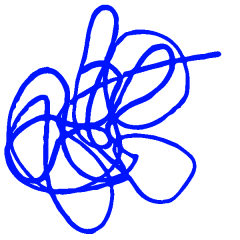After making a website for “Triangulate 1“ I wanted to revive it for “Triangulate 3“ and so some improvements on it. Since the feedback, I got mainly surrounded talking out the facial features from the website and just having abstract shapes in there, I created some additional shapes. Another feedback I got was that many wanted to scale and rotate the shapes but couldn’t. Since I don’t know how to do that on a website I just included a bigger variety of shapes to work with.
I also adjusted the prompt and instead of having the website user create something related to identity. I narrated the situation by telling the user that they are the first human to make contact with an unknown entity, an extraterrestrial and they have to construct a way of greeting them through the abstract shapes.
You can access the Website here: https://unit2.cargo.site
I looked at the greetings that were incorporated in 55 languages on the Golden Record and thought that this could be an interesting prompt to create the abstract symbol of a first encounter.
See the greetings here: https://voyager.jpl.nasa.gov/golden-record/whats-on-the-record/greetings/
I sent the website to several people and collected their creations. I noticed that some were using the website how I intended them to use it but some were intrigued by the shapes and the freedom of arranging them in any way that they created very random and fun images. The website seemed to evoke a way of being creative through arranging pre-made shapes. The fact that this image/symbol etc. was meant to communicate with the unknown also seemed liberating and can be quite a therapeutic conversation that is about to begin.
Here are some of the images/symbols that were created:







After collecting a few outcomes I wasn’t sure how to further process the imagery and also started thinking about further ways of exploring the question of „How to communicate with an unknown entity?“. What could be the closest way to talk to an unknown entity? I thought maybe an AI could help with that. An entity that learns from what you feed them. Since I have no idea how to code an AI I tried to find a way that comes closest to one. A chatbot implemented on a website could be a try. Here is a conversation with a generic chatbot I implemented on a site:

In my blog post „Triangulate 2: Feedback“ from the 20th November I mentioned the Lingua Cosmica by Hans Freudenthaler. His message to the unknown makes use of a possible common ground between us (humankind) and a potentially intelligent entity. But is there another common ground that one can make use of?
The artist Luigi Serafini created a book between 1976 and 1978 called Codex Seraphinianus. An encyclopedia which is made for no one and anyone. He illustrated a fantastical and surreal world that is accompanied by something that seems like a text in a foreign language. Serafini created the language to be indecipherable. A book that can be read by anyone since everyone sees something familiar to them or interprets it from their perspective. Could a common ground be created by ambiguity? Creating images that can be interpreted by the unknown? Is it possible to utilise ambiguity as a message vessel? It is definitely difficult to use ambiguity to communicate something specific. But it could be interesting if similar groups of individuals have a similar way of attaching meaning to an ambiguous image.




I wanted to test if ambiguity can become a way of communicating, so I created a set of images through „automatic drawing“. A method that the old surrealists used to tap into the subconscious to produce spontaneous imagery. The images shouldn’t be a direct depiction of anything concrete. They show familiarity in forms or objects or conditions but don’t necessarily constitute anything. The set of cards I made come with one prompt card. It should give the experiment a frame to collect information and measure what meaning gets attached to which image. The prompts are more about a way of communicating than just words. That’s why the prompts are about greeting someone, asking a question and telling someone about their emotions, etc.The experiment is still at the beginning and is to be continued.
Here is the set of 20 cards and the prompt card:





